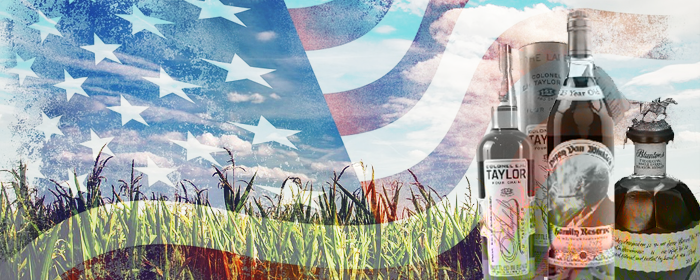We finally reach across the big pond and begin to track secondary market prices for Bourbon whiskies. The number of trades is steadily increasing while prices remain unstable. Here is our introduction to Bourbons (and some Rye).
When we analyse the secondary market for Bourbon whiskies, we must remember that all the auctioneers we currently track are European-based. So, in fact, this is an analysis of the European market’s take on the United State’s whiskies. However, when it comes to trading rare and collectable whiskies, the European market, especially the U.K., is most dominant (with Asia catching up steadily). Furthermore, many collectors around the globe rely on European auctioneers as no local auctioneer is available or supplies such an extensive range.
Growing Market
From January 2011 to November 2018, we observed 18.449 U.S. whiskies traded at the auction houses we track. Out of this, 16.635 were Bourbons and 1.814 were Ryes. In the graph below, we visualise the number of trades per month since 2011.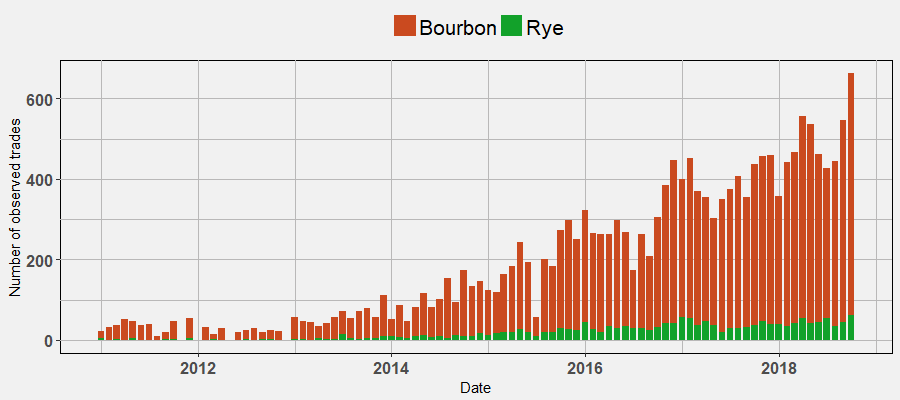
The number of traded U.S. whiskies is steadily increasing. It was only in 2014 when we began to observe more than 100 bottles trading each month on a regular basis. In late 2016 this number climbed above 400 for the first time. In the last month’s round of auctions, we observed more than 600 bottles traded. Compared to scotch single malts, where we observe thousands of trades each month, this number is comparably small, but it is increasing significantly.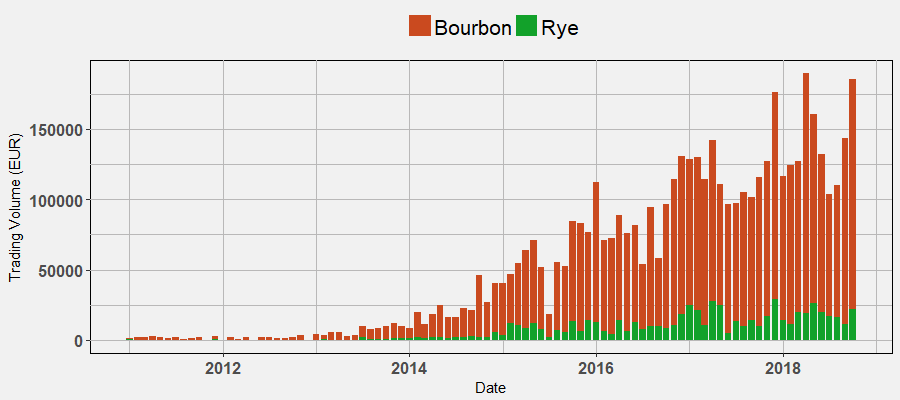
The same is true for the total trading volume per month. Since 2017 the sum of all prices paid each month for U.S. whisky consistently lies above 100.000 Euros. In some months, the total value of traded bottles even exceeded the 175.000 Euros threshold.
Major Brands
So what are the major brands when it comes to U.S. whisky? Our approach to this question examines the number of bottles traded. So in the visualisation below, we show the ten most often traded brands. We currently list 112 different United States whisky brands in our database.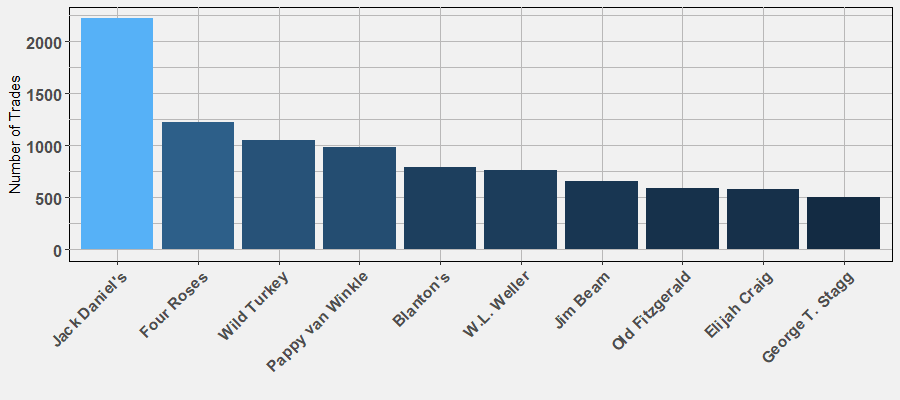
By far, the most trades are observed for Jack Daniel’s. Around 2.200 auctioned bottles equal a 12% market share for U.S. whiskies traded at auctions. Jack Daniels is followed by Four Roses, Wild Turkey and Pappy Van Winkle. When it comes to the infamous Van Winkle whisky, please note that we treat Van Winkle, Pappy van Winkle and Old Rip Van Winkle separately in this analysis.
Outstanding Bottles
Van Winkle is also the brand that dominates the list of the most outstanding Bourbon bottlings. First, we take a look at the most expensive Bourbons we observed. The Van Winkle 18yo Special Reserve Binny’s tops this list selling for 12.400 Euros in March 2016. This makes it the currently most expensive Bourbon in our whisky database. Back in 2014, this bottle was available for less than 1.000 Euros.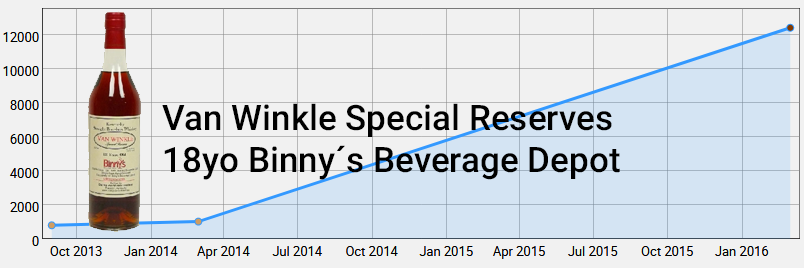
Also quite expensive is the Willet 19yo (1990) Cask 8552 bottling. It traded in October 2018 for 12.000 Euros. Other similar expensive examples include the Willet 24yo (1984) Cask 14 and the Heaven Hill 16yo (1994) Release 1.1.
We now turn our attention to the most traded American whiskies in our database. With more than 300 price observations, the Pappy Van Winkle 20yo Family Reserve was traded more often than any other Bourbon or Rye. The first price observations occurred in early 2014 when this whisky sold for around 450 Euros. Then prices climbed quickly and now stand at around 1.500 Euros per bottle.
The second most traded Bourbon we track is the Pappy Van Winkle 15yo Family Reserve which currently trades for around 1.000 Euros. Surprisingly the third most traded Bourbon is the Pappy Van Winkle 23yo Family Reserve, presently worth about 2.000 Euros. With 249 trades, the fourth-place belongs to a non Van Winkle Bourbon. For the W.L. Weller 12yo, we find 249 price observations of around a modest 100 Euros.
Finally, we want to ask which of the Bourbons and Ryes experienced the highest increase in value. In 2011, roughly nine years ago, the highest bidding price for the Old Weller Original 107 Proof was 44 Euros. In October 2018, the winning bid was 864 Euros. This equals an 1860% increase in value.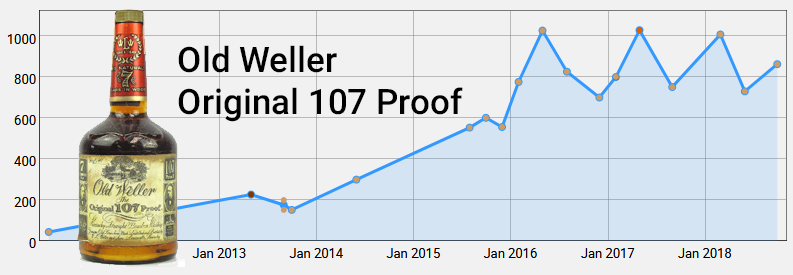
Another strong value gainer is the A.H. Hirsch 16yo (1974) Reserve. Once available for less than 100 Euros, the highest price observation is 1.900 Euros. Also, the Old Rip Van Winkle 12yo Old Time Rye gained value significantly. The 1.200 Euros from September 2017 equal an 1100% increase in value compared to the 100 Euros from October 2011.
Bourbon Index
To summarise the price development for all the Bourbons we have in our database, we use our proven method of calculating an index. Each month, we determine what the historically 100 most traded Bourbons were and then calculate their change in value. These monthly changes in value then define our index movements.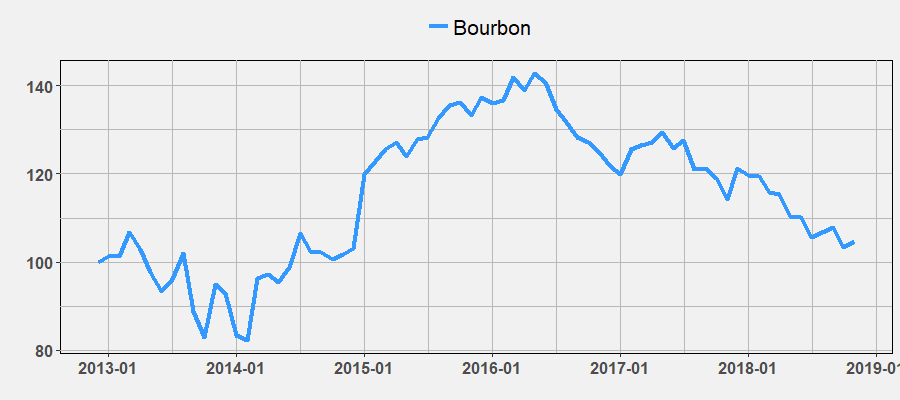
From 2014 onward, we see that when the number of traded Bourbons started to increase (see above), our Bourbon index steadily climbed. In the middle of 2016, it reached an index value of around 140. Over this two and half-year period, our Bourbon index gained more than 70%. However, since then, we have observed steadily decreasing index values. By late 2018 our Bourbon index stayed at around 105 points. We already know that beginning in 2016, more and more Bourbons began to appear on the market. Clearly, some of the most traded bottles are not very sought after by the secondary market.
You now find all the Bourbons we currently track in our whisky database. Add them to your personal collections to keep track of their changing prices.
Disclaimer: the whisky market insights presented in this article are based on the Whiskystats database at the time of publication. Whiskystats is constantly adding new data, and therefore some charts and figures may not match after initial publication.
